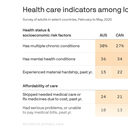The U.S. is an outlier when it comes to health disparities

Socioeconomic disparities in health care are significantly worse in the U.S. than in other wealthy countries, according to a new study by the Commonwealth Fund, published in Health Affairs.
Why it matters: Wealthy Americans have long had better access to care — and therefore better outcomes — than poor Americans. And the coronavirus' disproportionate impact on low-income Americans and people of color has made those disparities glaringly obvious.
What they found: "Adults with lower incomes in the U.S. were far more likely than those in the other high-income nations ... to go without needed health care because of costs, to face medical bill burdens, and to struggle to afford basic necessities such as housing and healthy food," the study's authors write.
- Low-income adults are more likely to have multiple chronic conditions in the U.S. than in the 10 other high-income countries. During the pandemic, these underlying conditions have translated into a higher risk of serious coronavirus infections.
- On every measure of health status, as well as affordability and access to primary care, the U.S. reported some of the largest income disparities.
Yes, but: Higher-income Americans were also more likely to forgo health care because of the cost than their affluent peers in most other countries.
Between the lines: The U.S. was the only country studied that doesn't have universal health coverage along with some form of cost protections.
- The U.S. also underinvests in primary care, whereas most of the other countries in the study have national policies that support strong primary care.
- We also invest less in social determinants of health and social services.
The bottom line: These disparities have real-world implications every day. But they've been vividly on display over the last nine months, as vulnerable populations have consistently been more likely to be infected by the virus and, ultimately, to die from it.